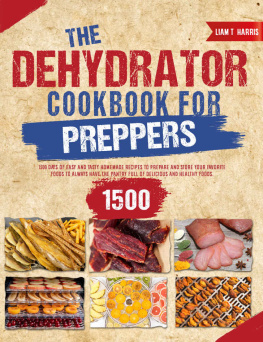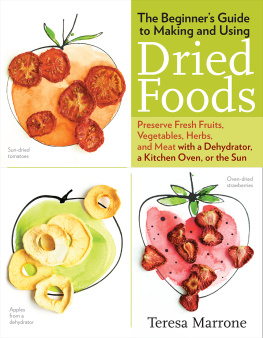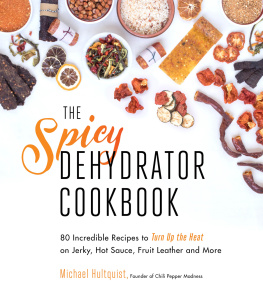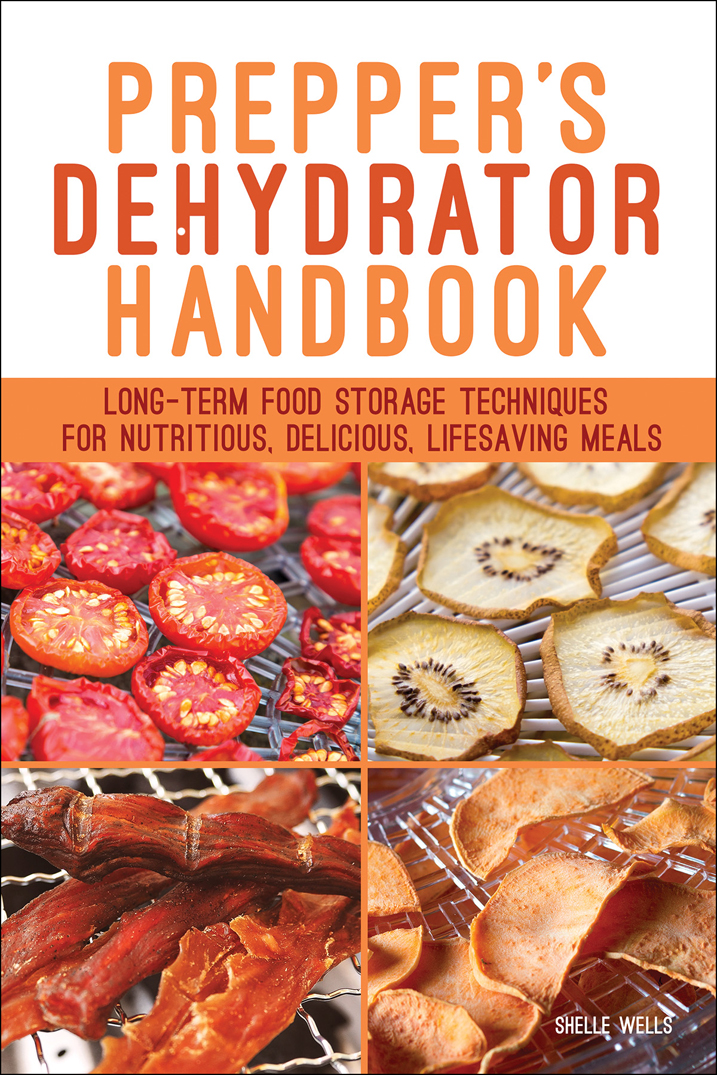Table of Contents
Guide

Text copyright 2018 Shelle Wells. Design and concept copyright 2018 Ulysses Press and its licensors. All rights reserved. Any unauthorized duplication in whole or in part or dissemination of this edition by any means (including but not limited to photocopying, electronic devices, digital versions, and the internet) will be prosecuted to the fullest extent of the law.
Published in the United States by:
Ulysses Press
P.O. Box 3440
Berkeley, CA 94703
www.ulyssespress.com
ISBN: 978-1-61243-809-2
Acquisitions editor: Casie Vogel
Managing editor: Claire Chun
Project editor: Shayna Keyles
Proofreader: Renee Rutledge
Front cover and interior design: what!design @ whatweb.com
Cover artwork: all from shutterstock.com: dried cherry tomatoes Sergiy Bykhunenko; dried golden kiwis corners74; dried sweet potatoes julie deshaies; dried meat successo images; dried apples marketlan
Interior artwork: page 35 TotemArt/shutterstock.com
Production: Caety Klingman
Distributed by Publishers Group West
IMPORTANT NOTE TO READERS: This book is independently authored and published and no sponsorship or endorsement of this book by, and no affiliation with, any trademarked brands or other products mentioned within is claimed or suggested. All trademarks that appear in ingredient lists and elsewhere in this book belong to their respective owners and are used here for informational purposes only. The author and publisher encourage readers to patronize the quality brands mentioned and pictured in this book.
To Steve, who always believes in the possibilities.
CONTENTS
We do not know the name of the first master dehydrator, that innovator who recognized that apples left outside in intense sunshine could be saved and eaten later. Their story is old, perhaps as old as Egyptian civilization, and lost in time. However, it is safe to say that drying food as a preservation method has been around for as long as people have been keeping records.
During the Middle Ages, people in Europe built rooms as an extension of distilleries that were specifically designed to dehydrate food by the heat of an indoor fire. Food was strung across the room, smoked, and dried. The lack of sunlight and dry days made it impossible to dry food outside, and these specialty houses solved the problem for people living in a cool, wet climate.
By the mid-1800s, a process was developed so vegetables could be dried at 105F and compressed into cakes. These dried vegetables were a welcome source of nutrition for sailors who suffered through long voyages without fresh food. During World War II, soldiers used dehydrated food as lightweight rations while serving on the battlefield. We know these today as meals ready to eat (MREs). After the war, housewives did not rush to add this compact, but often tasteless, food into their daily cooking routines, and dehydrated food fell out of favor.
We probably have the backpacking community to thank for the modern resurgence of dehydrated food. Their demand for simple, lightweight, and nutritious meals has created a need for prepackaged fruit, vegetables, side dishes and full-course meals, along with a renewed interest in dehydrating machines and other means of drying foods. These new convenience foods can be found at any grocery and outdoor store and are known for their easy preparation and quick cooking time. The taste has improved so much that you would consider it a fine dinner. Modern preppers have taken this challenge a step further by learning to produce, store, and rotate a years worth of food in their own prepared pantry.
This guidebook teaches you the basics of dehydrating fruit, vegetables, and protein; gives detailed information about drying 50 types of fruits and vegetables; and shares some time-tested and family-loved recipes for everyday use. Everything you need to learn to stock your own healthy, shelf-stable pantry is included.
As a prepper who is also a gardener, I wish to take my pantry preparations beyond beans, rice, wheat, and powdered eggs. Dehydrating my garden bounty fills the gap left by food that cant be canned and a freezer susceptible to power outages. A clean water source and fire are the only things that stand between my family and a hot meal prepared with dehydrated ingredients.
This book is not just for experienced gardeners, conscientious preppers, and expert preservers. It is for anyone who loves fresh food and wants to have a hand in how it is preserved. To accommodate the active lifestyles of today, dehydrating needs to fit easily into your daily routine, take as little time as possible, and require a minimum amount of preparation time. By combining bulk buying with batched preserving sessions, as well as an efficient dehydrator, you can be drying food to use every day.
Anyone can use this book, including:
Preppers who want to create a healthy years supply of food that is tailor-made for their familys dietary needs.
Homesteaders who have the land to plant additional crops and want to create their own extended pantry supply.
Busy families who want to purchase in bulk and have ingredients for quick, healthy meals at their fingertips.
Suburban and urban gardeners who are trying to grow and preserve their harvest in an efficient way.
Parents who want to replace their childrens consumption of sugary and empty-calorie snacks with healthy alternatives.
My dream is that after you learn how to dehydrate, you will see the possibilities for quick, healthy meals and begin to use these techniques every day. May you never waste another orange peel, wilted celery stick, or bag of spinach again!
Years ago, when I was just beginning to get serious about putting together a food storage plan, my husband and I decided to purchase a side of beef from a local farmer. Our extra chest freezer was in a detached garage about 20 feet from the house, and we loaded it up with all the wonderful cuts we had asked the processor to wrap for us. That chest freezer was full of frozen meat, vegetables, and fruit with enough to last for months and months of homemade meals. It was fantasticand stupid.
One day I went out to get a roast and found that the kids had rummaged through the freezer several days earlier and the lid had not closed properly. Yepall the food inside had thawed, and all our hard work and money went down the drain, gone, ruined.
I learned a valuable food storage lesson that day. The rule of three in food preservation is to make sure that you do not put all your eggs in one basket; that is to say, you need to have your food stored in at least three separate ways. Of course, youll still want to have food in the freezer, but learning to process food in canning jars using a water bath and pressure canner is important too. Dehydrating fills the gap and allows you to have another avenue of properly stored food that has a long-term shelf life.
Since that day we have never had a food storage catastrophe hit us with that much force. We use canning, freezing, and dehydrating to round it all out. If the jars break or the freezer gets left open again, we will not lose all of our food supplies.
One of the reasons I like dehydrating so much is because it is easy, and there is only a small learning curve to get started. Basically, if you can chop food, blanch vegetables, and know what specific food should look like when it is completely dry, you can be successful in adding dehydrated food to your pantry.
Next page








![Tammy - The ultimate dehydrator cookbook : [the complete guide to drying food, plus 398 recipes, including making jerky, fruit leather, and just-add-water meals]](/uploads/posts/book/102970/thumbs/tammy-the-ultimate-dehydrator-cookbook-the.jpg)
![Ferguson September - The ultimate dehydrator cookbook: [the complete guide to drying food, plus 398 recipes, including making jerkey, fruit leathers, and just-add-water meals]](/uploads/posts/book/85869/thumbs/ferguson-september-the-ultimate-dehydrator.jpg)

